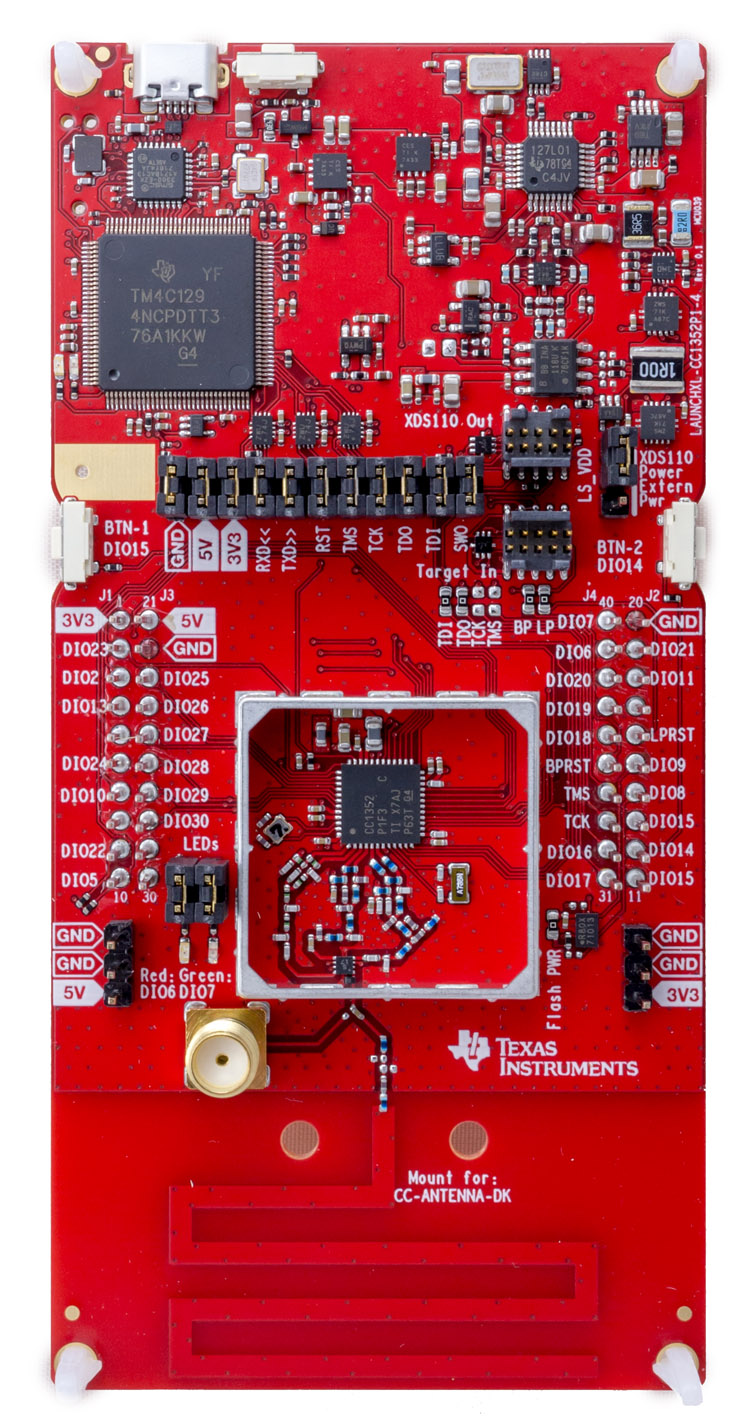2020-04-27 19:53:07 +02:00
|
|
|
/**
|
|
|
|
|
@defgroup boards_cc1352p_launchpad TI CC1352P LaunchPad
|
|
|
|
|
@ingroup boards
|
|
|
|
|
@brief Texas Instruments SimpleLink(TM) CC1352P Wireless MCU LaunchPad(TM) Kit
|
|
|
|
|
|
2021-02-17 11:02:40 +01:00
|
|
|
## <a name="cc1352p_launchpad_toc"> Table of Contents </a> [[TOC]](#cc1352p_launchpad_toc)
|
|
|
|
|
|
|
|
|
|
1. [Overview](#cc1352p_launchpad_overview)
|
|
|
|
|
2. [Hardware](#cc1352p_launchpad_hardware)
|
|
|
|
|
3. [Board pinout](#cc1352p_launcpad_pinout)
|
|
|
|
|
4. [Flashing the Device](#cc1352p_launchpad_flashing)
|
|
|
|
|
|
|
|
|
|
## <a name="cc1352p_launchpad_overview"> Overview </a> [[TOC]](#cc1352p_launchpad_toc)
|
2020-04-27 19:53:07 +02:00
|
|
|
|
|
|
|
|
The [LAUNCHXL-CC1352P](http://www.ti.com/tool/LAUNCHXL-CC1352P) is a Texas
|
|
|
|
|
Instrument's development kit for the CC1352P SoC which combines dual-band wireless MCU
|
|
|
|
|
with integrated power amplifier.
|
|
|
|
|
|
2021-02-17 11:02:40 +01:00
|
|
|
## <a name="cc1352p_launchpad_hardware"> Hardware </a> [[TOC]](#cc1352p_launchpad_toc)
|
2020-04-27 19:53:07 +02:00
|
|
|
|
|
|
|
|

|
|
|
|
|
|
2021-02-17 11:02:40 +01:00
|
|
|
| MCU | CC1352R1 |
|
|
|
|
|
|:----------------- |:--------------------- |
|
|
|
|
|
| Family | ARM Cortex-M4F |
|
|
|
|
|
| Vendor | Texas Instruments |
|
|
|
|
|
| RAM | 80KiB |
|
|
|
|
|
| Flash | 352KiB |
|
|
|
|
|
| Frequency | 48MHz |
|
|
|
|
|
| FPU | yes |
|
|
|
|
|
| Timers | 4 |
|
|
|
|
|
| ADCs | 1x 12-bit (channels) |
|
|
|
|
|
| UARTs | 2 |
|
|
|
|
|
| SPIs | 2 |
|
|
|
|
|
| I2Cs | 1 |
|
|
|
|
|
| Vcc | 1.8V - 3.8V |
|
|
|
|
|
| Datasheet | [Datasheet](http://www.ti.com/lit/ds/symlink/cc1352p.pdf) (pdf file) |
|
|
|
|
|
| Reference Manual | [Reference Manual](http://www.ti.com/lit/ug/swcu185d/swcu185d.pdf) |
|
|
|
|
|
|
2020-04-27 19:53:07 +02:00
|
|
|
The board comes in two variants with different RF matching network on the 20 dBm PA output port:
|
|
|
|
|
|
|
|
|
|
- LAUNCHXL-CC1352P1: 868/915 MHz up to 20 dBm, 2.4 GHz up to 5 dBm
|
|
|
|
|
- LAUNCHXL-CC1352P-2: 868/915 MHz up to 14 dBm, 2.4 GHz up to 20 dBm.
|
|
|
|
|
|
2021-02-17 11:02:40 +01:00
|
|
|
## <a name="cc1352p_launchpad_pinout"> Board pinout </a> [[TOC]](#cc1352p_launchpad_toc)
|
2020-04-27 19:53:07 +02:00
|
|
|
|
2021-02-17 11:02:40 +01:00
|
|
|
The [LAUNCHXL-CC1352P1 Quick Start Guide](https://www.ti.com/lit/ug/swau108a/swau108a.pdf)
|
|
|
|
|
provides the default pinout for the board.
|
2020-04-27 19:53:07 +02:00
|
|
|
|
2021-02-17 11:02:40 +01:00
|
|
|
## <a name="cc1352p_launchpad_flashing"> Flashing the Device </a> [[TOC]](#cc1352p_launchpad_toc)
|
2020-04-27 19:53:07 +02:00
|
|
|
|
2021-02-17 11:02:40 +01:00
|
|
|
Flashing RIOT is quite straight forward. The board comes with an XDS110 on-board
|
|
|
|
|
debug probe that provides programming, flashing and debugging capabilities
|
|
|
|
|
through the USB Micro-USB connector. Once either TI Uniflash or OpenOCD are
|
|
|
|
|
installed just connect the board using the Micro-USB port to your computer and
|
|
|
|
|
type:
|
2020-04-27 19:53:07 +02:00
|
|
|
|
|
|
|
|
```
|
2021-02-17 11:02:40 +01:00
|
|
|
make flash BOARD=cc1352p-launchpad
|
2020-04-27 19:53:07 +02:00
|
|
|
```
|
|
|
|
|
|
2021-02-17 11:02:40 +01:00
|
|
|
To use OpenOCD instead of uniflash we need to set the `PROGRAMMER` environment
|
|
|
|
|
variable, this is to enable OpenOCD instead of Uniflash.
|
2020-04-27 19:53:07 +02:00
|
|
|
|
|
|
|
|
```
|
2021-02-17 11:02:40 +01:00
|
|
|
export PROGRAMMER=openocd
|
2020-04-27 19:53:07 +02:00
|
|
|
```
|
|
|
|
|
|
2021-02-17 11:02:40 +01:00
|
|
|
Now we can just do `make flash` and `make debug`, this all using OpenOCD.
|
2020-04-27 19:53:07 +02:00
|
|
|
|
2021-02-17 11:02:40 +01:00
|
|
|
For detailed information about CC1312 MCUs as well as configuring, compiling
|
|
|
|
|
RIOT and installation of flashing tools for CC1312 boards,
|
|
|
|
|
see \ref cc26xx_cc13xx_riot.
|
2020-04-27 19:53:07 +02:00
|
|
|
|
|
|
|
|
|
|
|
|
|
*/
|